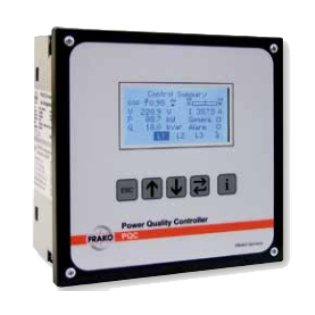FRAKO power factor control relays help in solving complex problems ranging far beyond the pure control of reactive power to a set target cos phi. Their innovative control characteristics meet all the requirements of modern industrial networks and make these control relays suitable for all applications. Their high accuracy and sensitivity even in networks heavily polluted with harmonics make them suitable for power generation installations and installations which provide continuous or sporadic feed-in to the supply network.
All components of a power factor correction system are operated carefully by these control relays and protected from overloads. This results in a markedly increased life expectancy for the system.
Features
- Fully automatic and simple commissioning
- Patented control characteristic – no overcompensation during low load
- Measurement and monitoring of harmonics
- Overcurrent trip function – Protection for capacitors
- No-voltage and zero-current release
- Four-quadrant regulation
- Automatic adjustable switching delay
- Versatile indication and messages in the display

Types
We have four different types of Power Factor relays, click on the tabs below to find more about the features of them .
PQC Power Quality Controller - RM2106 or RM2112 – User Friendly 6 by12 step PF Controller
The controller for maximum reliability in meeting tomorrow’s power quality needs.
The PQC Power Quality Controller adds powerful new functionality to the well-known strengths of the FRAKO Reactive Power Control Relays to meet the challenges posed by state-of-the-art power quality systems.
With its built-in microprocessor, the PQC handles tasks over and above classical power factor correction. The possibility of parameterizing each individual controller enables the PQC to be used anywhere, making it the best possible instrument for controlling power quality in contemporary industrial supply networks.
The PQC is characterized by user-friendly features such as simple installation, intuitive operation and the automatic start-up already known from FRAKO Reactive Power Control Relays. In addition, an integrated self-monitoring function improves long-term operational reliability, thus helping to reduce costs and minimize the risk of network disruptions.
Key Features
- 1- or 3-phase measurement
- 4-quadrant control
- 6 or 12 switching outputs + 1 alarm contact
- 5 parameterizable control curves
- Graphical user interface with plain text menu in choice of languages
- Integrated monitoring of
Recommended Applications
The PQC is suitable for 4-quadrant power factor correction in:
- Consumer networks
- Power generation networks
- Low and medium voltage networks
- Power factor correction systems with or without detuning
Instrument Versions
The PQC is designed primarily for mounting in a 138 x 138 mm cutout in the front of a control panel. Different versions of the instrument can be selected to suit the required application. These differ essentially according to:
- Instrument power supply
- Number of measurement inputs
- Number and rating of switching outputs
Combinations of these parameters mean that 6 different basic types are available:
Instruments with 100–240 V, 50/60 Hz Power Supplies
| Type | Measurement Inputs | Switching Outputs |
|---|---|---|
| PQC 1202401-0 | 1 V/I | 12 x 250 V / 3 A |
| PQC 1202403-0 | 3 V/I | 12 x 250 V / 3 A |
| PQC 0602401-0 | 1 V/I | 6 x 250 V / 3 A |
Instruments with 100–480 V, 50/60 Hz Power Supplies
| Type | Measurement Inputs | Switching Outputs |
|---|---|---|
| PQC 1204801-0 | 1 V/I | 12 x 250 V / 3 A |
| PQC 1204803-0 | 3 V/I | 12 x 250 V / 3 A |
| PQC 0614801-0 | 1 V/I | 6 x 440 V / 3 A |
The inputs for the measured voltage are designed for 100-690 V, 50/60 Hz; those for the measured current are designed for use with x/1A or x/5A current transformers.
Operating the PQC
The PQC has a backlit monochrome LC display with 128 × 64 pixels, plus 5 keys for navigating the plain language (German, English or French) menu.
The menu is structured in an intuitive way that makes it easy to program the instrument. An overview of the controller in the display shows the key information for the individual phases together with the status of the switching outputs. The operator is thus given all relevant information on the state of the power factor correction system at a glance. An intelligent alarm management function alerts the operator to critical conditions, either by messages in the display, via the alarm contact, or both, as desired.
Commissioning the PQC
When first started up, the PQC automatically determines the system configuration to which it is connected plus the switching outputs in use with their respective capacitance ratings (in kvar). The operator selects the appropriate control profile for the application or parameterizes the PQC to meet the required specifications. Five control profiles—specially developed for the most frequently encountered applications—are saved in the instrument before it leaves the factory. On completion of the start-up procedure, the PQC switches the connected capacitor stages in or out according to the selected control curve.
